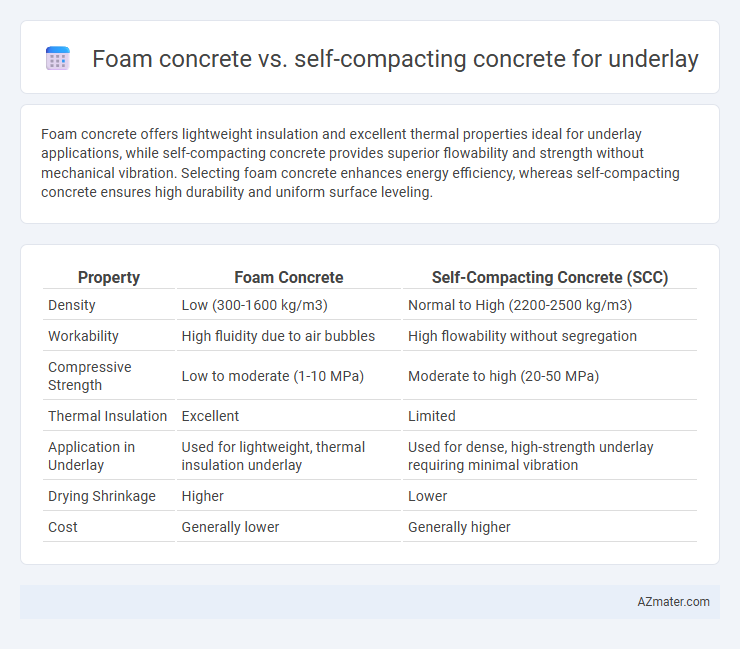Foam concrete offers lightweight insulation and excellent thermal properties ideal for underlay applications, while self-compacting concrete provides superior flowability and strength without mechanical vibration. Selecting foam concrete enhances energy efficiency, whereas self-compacting concrete ensures high durability and uniform surface leveling.
Table of Comparison
| Property | Foam Concrete | Self-Compacting Concrete (SCC) |
|---|---|---|
| Density | Low (300-1600 kg/m3) | Normal to High (2200-2500 kg/m3) |
| Workability | High fluidity due to air bubbles | High flowability without segregation |
| Compressive Strength | Low to moderate (1-10 MPa) | Moderate to high (20-50 MPa) |
| Thermal Insulation | Excellent | Limited |
| Application in Underlay | Used for lightweight, thermal insulation underlay | Used for dense, high-strength underlay requiring minimal vibration |
| Drying Shrinkage | Higher | Lower |
| Cost | Generally lower | Generally higher |
Introduction to Underlay Concrete Solutions
Foam concrete and self-compacting concrete are advanced underlay concrete solutions designed to enhance structural performance and efficiency. Foam concrete offers lightweight properties and excellent thermal insulation, making it ideal for void filling and thermal underlays. Self-compacting concrete delivers superior flowability and high-strength characteristics, enabling faster placement and dense compaction without mechanical vibration.
What is Foam Concrete?
Foam concrete is a lightweight material produced by mixing cement, water, and foam to create a cellular structure that reduces density while maintaining adequate compressive strength. It offers excellent thermal insulation, fire resistance, and sound absorption, making it suitable for underlay applications where weight reduction and thermal efficiency are critical. Unlike self-compacting concrete, foam concrete requires less vibration during placement due to its flowable nature and is often used to fill voids and provide a leveled base with minimal shrinkage.
What is Self-Compacting Concrete?
Self-compacting concrete (SCC) is a highly flowable, non-segregating concrete that can spread into place and fill formwork without mechanical vibration, making it ideal for underlay applications requiring smooth, uniform surfaces. Unlike foam concrete, which incorporates air bubbles to reduce density and improve insulation, SCC uses superplasticizers and viscosity modifiers to achieve exceptional workability and surface finish. This advanced mix design enhances early strength development and durability, providing a reliable underlay solution where dense, consistent compaction is critical.
Key Material Properties Compared
Foam concrete offers low density and excellent thermal insulation due to its entrapped air bubbles, making it ideal for lightweight underlay applications, while self-compacting concrete (SCC) boasts superior flowability and high compressive strength, ensuring better load-bearing capacity and surface finish without the need for vibration. Foam concrete typically has lower compressive strength (approx. 1-10 MPa) and higher porosity compared to SCC, which can reach compressive strengths of 20-50 MPa with minimal voids. The water absorption and shrinkage rates are generally higher in foam concrete, whereas SCC demonstrates enhanced durability and dimensional stability under load.
Ease of Placement and Workability
Foam concrete offers exceptional ease of placement due to its lightweight and flowable nature, enabling quick filling of irregular cavities with minimal compaction effort. Self-compacting concrete excels in workability by its high flowability and passing ability, requiring no vibration, which ensures uniform surface finish and dense consolidation even in complex formworks. Comparing both, foam concrete stands out for lightweight underlay applications, while self-compacting concrete provides superior surface quality and structural performance in demanding placements.
Structural Performance and Strength
Foam concrete offers lightweight properties with lower compressive strength typically ranging between 1.5 to 8 MPa, making it suitable for non-load-bearing underlay applications where thermal insulation and reduced dead load are priorities. Self-compacting concrete (SCC) achieves higher structural performance with compressive strengths commonly exceeding 25 MPa, providing excellent flowability and density for uniform load distribution and enhanced durability in structural underlay use. The choice between foam concrete and SCC for underlays depends primarily on the required strength, load-bearing capacity, and surface finish specifications.
Thermal and Acoustic Insulation
Foam concrete offers superior thermal insulation due to its lightweight, porous structure that traps air, significantly reducing heat transfer in underlay applications. Self-compacting concrete, while denser and stronger, provides less effective acoustic insulation compared to foam concrete because of its reduced porosity. The choice between foam and self-compacting concrete for underlay depends on prioritizing either enhanced thermal insulation or structural integrity with moderate sound attenuation.
Cost Considerations and Economic Efficiency
Foam concrete offers significant cost savings due to its lightweight properties, reduced material consumption, and low energy requirements during production, making it economically efficient for underlay applications. Self-compacting concrete, while more expensive initially because of specialized admixtures and higher cement content, reduces labor costs and accelerates construction timelines due to its superior flowability and compaction without vibration. Choosing between foam concrete and self-compacting concrete depends on balancing upfront material costs against long-term savings in labor and time for efficient underlay installations.
Environmental Impact and Sustainability
Foam concrete offers significant environmental benefits due to its lightweight nature and use of recycled materials, resulting in lower carbon emissions during production and transport. Self-compacting concrete reduces waste and energy consumption by optimizing mix design and eliminating the need for mechanical vibration, contributing to sustainability in construction. Both materials enhance thermal insulation and durability, but foam concrete typically has a greater impact on reducing overall environmental footprint for underlay applications.
Best Applications: Choosing the Right Underlay
Foam concrete offers lightweight and excellent thermal insulation properties, making it ideal for underlay in flooring systems where load reduction and insulation are priorities. Self-compacting concrete provides superior flowability and high early strength, suited for complex formworks and densely reinforced structures requiring minimal vibration during placement. Selecting the right underlay depends on project-specific requirements such as load-bearing capacity, surface finish, and environmental conditions to ensure optimal performance and durability.

Infographic: Foam concrete vs Self-compacting concrete for Underlay
 azmater.com
azmater.com